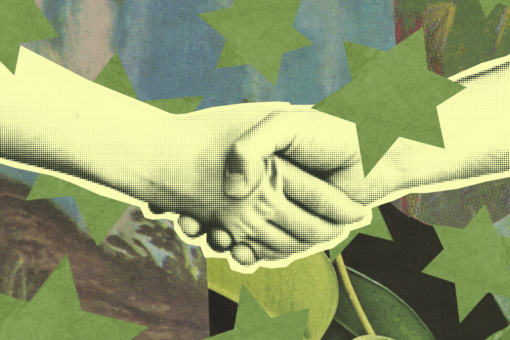The history of weed is not Jewish.
Since — well, since an incalculable always — Jews have been debating what it means to be us. In the Torah, in the Talmud, in synagogue pews and multilingual scrolls of poetry and nondescript cafeterias, we wonder what sets us apart, what renders us so Jewish. In the history of these far-reaching conversations, weed has never been a prominent talking point.
But in 2020, at an archaeological site in the Negev desert called Tel Arad, archaeologists made a surprising discovery. Using new chemical analysis techniques, they examined burnt residues on a pair of limestone altars. The residue on one of the altars, it turns out, was none other than Mary Jane. The devil’s lettuce. Call it what you will; it was weed.
When I first read about the discovery, I was fascinated. Was weed a part of my people’s history? Did my ancestors sit around a temple in drug-induced, head-buzzing ecstasy? By smoking it, could I connect to them? Could I call weed my ritual?
I turned to Dr. Gary Gilbert, Associate Professor of Religious Studies and specialist in ancient Jewish history at Claremont McKenna College, for advice. His response? It’s complicated.
According to Professor Gilbert, the presence of cannabis residue on a single altar at Tel Arad does not tell us much. The news created a big splash when it was first reported, but there is a “sobering quality when we start to reflect on it.” While that biblical ashtray indicates that the Israelites who worshiped at Ted Arad burned cannabis, we still do not know how they used it, or how often, or why.
Further, Professor Gilbert says, Tel Arad is a somewhat unusual site. Situated in the southern part of what was once the Kingdom of Judah, the sanctuary included large stone pillars, called massebot. In Leviticus, the prohibition against such pillars is clear. “You shall not make idols for yourselves, or set up for yourselves carved images or pillars, or place figured stones in your land to worship upon,” God commands.
In addition, the very existence of the Tel Arad site is curious. Since it was located outside Jerusalem, the sanctuary at Tel Arad contradicted efforts to centralize worship in ancient Israel.
Clearly, the Jews at Tel Arad were rebellious. Was it because they were stoners? Throughout human history and around the world, smokers of weed have been behind major cultural shifts and revolutionary movements. Maybe the Jews of Tel Arad were no different. Not only did they defy Leviticus’s instruction against placing “figured stones” in their land — they, altar-burners of cannabis, made of themselves stoned figures. (Allow me one bad joke.)
That is, if they burned cannabis at all. After all my research, what is clearest to me is that my perspective is far too modern. I will never know what the Jews at Tel Arad did. We might never know. The massebot are blank, lacking any decoration. The limestone pillar on which the cannabis residue was found has only blackened, ancient soot to show for itself. Archaeologists have found no artisan bongs lying around. The writing is not on the wall.
Indeed, beyond that one sooty pillar at Tel Arad, the evidence is tenuous at best. My Google search yields a Haaretz article profiling Boston geriatrician, mohel and former IDF lieutenant Yosef Glassman, who believes that instructions in Exodus to “take spices of the finest sort,” including “pure myrrh, five hundred shekels, fragrant cinnamon, and ‘keneh bosem’” might refer to weed. However, the literal translation of “keneh bosem” is “sweet cane.” Calling it cannabis seems like quite the stretch.
The Times of Israel tells me about Michael Steinmetz, a “nice Jewish boy” with an engineering degree from Carnegie Mellon. Today, he is the co-founder and CEO of Flow Kana, one of the “hottest privately held cannabis companies in North America.”
I learn that it was Israeli researchers Raphael Mechoulam and Yechiel Gaoni who were the first to isolate tetrahydrocannabinol (THC), the psychoactive component of hashish, in the 1960s. I learn that the Israeli government funds research on medical marijuana, which is distributed at a state-run center. I learn about the Israeli medical marijuana company Tikun Olam, “the world’s first organization licensed by a national government to treat patients with medical cannabis.” I find countless articles on the question of whether marijuana is kosher. “As long as you smoke it,” says one. Chabad claims that the answer depends on how you define the word “kosher.”
I read and I laugh and I learn. But I do not find the answer to my question. Is there a Jewish history of weed? No one seems to know.
I think back to a passage Professor Gilbert shared from the 13th-century Spanish rabbi and scholar Bahya ben Asher. Behya wrote that the “purest of foods were created for attaining higher knowledge.” Naturally, my first thought was of Eden, of that succulent, forbidden fruit.
I think the point is this: We don’t know what the fruit was. Was it an apple, a pomegranate, a fuzzy orange peach? When Jews ask, our real question is this: What were we like, before? How did we exist? What did we reach for?
We cannot taste the fruit. We will never know the answer.
Today, we attempt to visualize our past, our ancient experience. There are no limits to our imagination. Can we imagine our ancestors getting high and dancing in the temple? Can we imagine them praying to forbidden pillars despite their kingdom’s disapproval? Can we imagine them, and ourselves, differently?
This is a thought experiment. Writing a Jewish history of weed, I have realized, is really about imagining a Jewish history, period. There is so much we do not know about our origins. In this gray area of self-knowledge, perhaps weed presents an avenue for us to connect with the sensations our ancestors felt. Did they delight in dates and pomegranates? Did the seeds burst unrelenting sweetness in their mouths as they spoke the ancient languages we will never speak? Did they have extraordinary, weed-enhanced orgasms as they created the children who would become our ancestors, too?
How did our ancestors experience God? How did they reach for transcendence? If they smoked weed, why didn’t they tell us about it?
In conversation with our unknowable history, the figures to whom we speak are our own reflections, multiple and various. We reach for them. They do not yield.
The point is that we ask, our questions diffusing through the air like the frankincense and myrrh and, possibly, the spiky green leaves that our ancestors burned in their now-ruined temples. The point is that we wonder, that we delight. What’s more Jewish than that?



